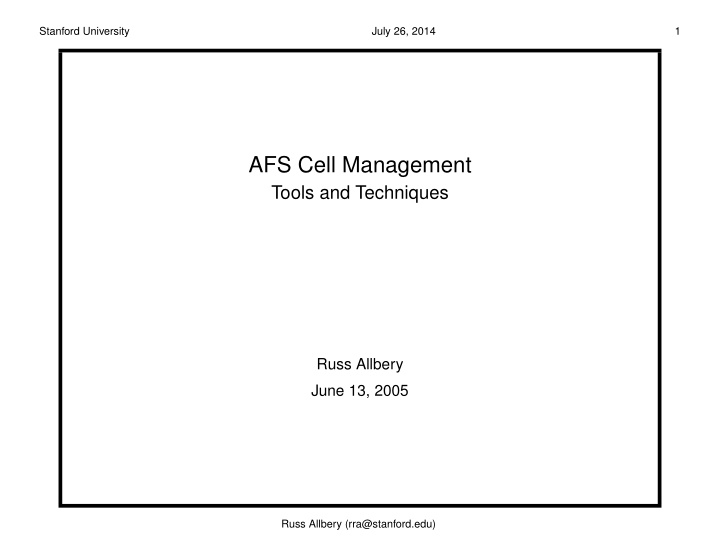



Stanford University July 26, 2014 1 AFS Cell Management Tools and Techniques Russ Allbery June 13, 2005 Russ Allbery (rra@stanford.edu)
Stanford University July 26, 2014 2 Introduction • Stanford has 3.9TB of data in AFS, in 57,485 volumes (as of June 1st). (1.6TB user home directories, 660GB data, 180GB groups and departments, 550GB classes). • Administration when no migrations are in progress takes a few hours a week, mostly creating unusual volumes, moving volumes around, and upgrading servers. • Tools presented here developed by Neil Crellin. • http://www.eyrie.org/˜eagle/software/ • http://www.eyrie.org/˜eagle/notes/afs/ Russ Allbery (rra@stanford.edu)
Stanford University July 26, 2014 3 Contents • Volume creation and management • Managing ACLs • Analysis and reporting • Replicated volumes • Monitoring with Nagios Russ Allbery (rra@stanford.edu)
Stanford University July 26, 2014 4 Creating Volumes • volcreate wrapper to balance where volumes are placed • Mapping volume types to servers • Size policy (2-4GB max for ease of moving volumes) • Automated log volume creation with volcreate-logs • Wrapper scripts for volume types ( create-user , etc.) Russ Allbery (rra@stanford.edu)
Stanford University July 26, 2014 5 Managing Volumes • partinfo wrapper for usage information • mvto utility for all volume moving • Generating volume lists with vos listvol • Checking for unreleased volumes with unreleased • Balacing: why or why not, and possible overkill solutions • volnuke wrapper to delete volumes • Delegated volume creation ability ( remctl and afs-backend ) Russ Allbery (rra@stanford.edu)
Stanford University July 26, 2014 6 Managing ACLs • One PTS group per course, department, or group volume • Help desk tools to change PTS group membership (and volume quota) • fsr wrapper for users • Be careful of IP-based ACLs: subnets work best, better to use kstart and machine srvtabs over IP ACLs • Log volume ACLS (lik) and the potential problems • Think about fs cleanacl • Unix directory owners and their special ACLs Russ Allbery (rra@stanford.edu)
Stanford University July 26, 2014 7 Tracking Volumes • Hierarchical naming scheme for volumes • Mount point database ( mtpt , loadmtpt , cleanmtpts ) • Nightly load into an Oracle database • Nightly reports from the Oracle database (released volumes, high accesses, volumes moved, unreleased changes, missing mount points) • Monthly usage reports Russ Allbery (rra@stanford.edu)
Stanford University July 26, 2014 8 Replicated Volumes • Replication helps when server is down, not when it’s slow • How many replicas do you want? (2-4) • volcreate and server geographic locations • How RW and RO paths work: replicate the whole path • Delegated volume release ability ( remctl and afs-backend ) • frak to find changes • Restoring a RW from a RO with vos dump and vos restore Russ Allbery (rra@stanford.edu)
Stanford University July 26, 2014 9 Monitoring with Nagios • Basic tool: bos status • Monitor VLDB servers with udebug : pt 7002, vl 7003, ka 7004 • Available disk with vos partinfo • Connections waiting for thread ( rxdebug ) • AFS logs and kill -TSTP • Nightly problem reports from Oracle database Russ Allbery (rra@stanford.edu)
Recommend
More recommend